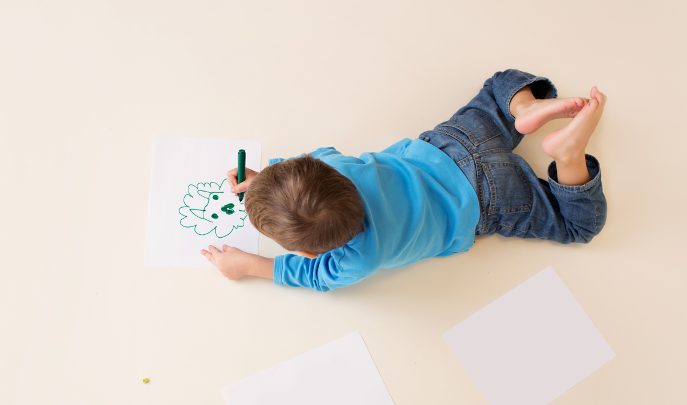“Mark Making Doesn’t Just Mean Paper And Crayons” – Imaginative Ideas To Engage Reluctant Writers

Plonking pencils and paper down on the nearest table isn’t enough to grab every child. Hilary White shares more creative suggestions

- by Hilary White
- Former nursery and primary teacher, freelance writer and consultant

Mark making is the young child’s first experience of expressing themselves on paper. What used to be dismissed as ‘just scribbles’ is now, quite rightly, recognised as an important and enjoyable part of the child’s development – both as a writer and an artist.
Through mark making, a child learns that they can change the appearance of a surface in whatever way they wish.
Access to a variety of mark-making resources and the opportunity for free-flow exploration also develops their ability to hold and manipulate pencils, crayons and paint brushes. These early discoveries and experiences are important because they show the child that mark making (and later writing and artwork) is an activity that they can take complete control of.
The individual who knows how to use a pencil or paint has endless creative possibilities at their fingertips – and mark making in the early years lays the all-important foundations.
Writing areas
Although ‘the writing corner’ is a traditional part of the early years setting, some settings are shifting away from having designated areas for single aspects of learning. It can be useful to set up a targeted observation of your writing area to assess how it is actually working. Make a note of which children use it, how often and for what purposes.
Which resources are the most and least popular, and is the area user friendly? It’s equally, if not more, important to note which children seldom or never use the writing area.
Where are they choosing to spend their time, and how could you interweave mark-making opportunities into the activities that they enjoy?
A dedicated writing area carries the underlying message that writing is separate from, rather than integral to, the rest of our lives. As children grow older and start to compare themselves with others, it can also be off-putting for the more reluctant writer to find the writing area constantly populated by confident mark makers.
If you choose to remove your writing area altogether, aim to replace it with mark-making opportunities throughout the setting. Observe how this works, and note any changes to the activity profile of your enthusiastic mark makers.
It’s possible to have too much of a good thing, and you may find that they start to engage in a wider variety of activities – particularly if mark making offers them a gateway to something new.
Throughout the setting
Introducing mark-making opportunities throughout the setting enables you to target resources. It also allows children to engage spontaneously with mark making as a seamless part of their play. For the more reluctant child, this type of interwoven provision can lift the pressure to pick up a pencil.
Carry out an audit of your setting and think creatively about how to incorporate mark making into different areas and activities.
Possibilities include water spray bottles and mark-making implements in the sand box; a mobile writing desk with paper, envelopes and postcards by the outdoor letter box; notice board, Post-its and paper strips for memos and lists in the home area; blank booklets near reading nooks for children to create their own books; a box of blank checklists and invoices beside the small world play garage, and a tin of patio chalk for mark making on walls and floors.
Mark making offers lots of open-ended play opportunities, but it can also have a specific purpose. Whenever possible, set up mark making and writing opportunities that provide ‘real-life’ rather than adult-generated rewards.
For example, create a snack bar where children must fill in an order form before they can have their snack. Devise a rota for popular activities requiring children to write their names on a whiteboard chart in order to get their turn.
Encourage children to create handmade greetings cards and enjoy the positive feedback. Plan a purposeful long-term group project, such as decorating the new wooden storage hut with patterns before coating with varnish.
Trending
Creating mark-making activities linked to different aspects of setting life also enables you to offer a variety of paper, card and other surfaces.
For example, outdoor writing using laminated card and wipe-away marker pens works well because the laminate is waterproof, while sticky labels are useful for adding names and titles to artwork. Walls, paving slabs, wooden fences, windows, crockery, old furniture, fabric and battered picture books all have potential as mark-making surfaces.
You can also provide paper in different formats, including tags, luggage labels, strips, speech bubbles, concertina books, old blank forms, envelopes and themed shapes such as paper ‘leaves’ for noting nature finds, or cut-out hearts for loving messages.
On the go
Providing portable storage units is a great way to ensure that mark making takes place throughout the setting. Backpacks and tool belts containing a selection of mark-making resources (including clipboards) can be used by individual children.
For children who want to explore in twos and threes, a handled plastic cleaning caddy works well. The caddy can be filled with general resources, or adapted to suit a particular activity such as exploring shapes or creating cards. Make a note of children who need encouragement to mark make and construct themed caddies based on their particular interests.
Encourage the children to carry a caddy to their chosen work space – and practise putting it back when they have finished, ready for someone else to use. You can also involve them in choosing what resources should go into the caddies.
A second-hand trolley is another means of offering both a mobile mark-making station and an upcycling project. Decorating the trolley provides children with purposeful mark-making opportunities, as well as helping them to take ownership of this new resource.
Stock the trolley with care, ensuring that your chosen items offer children interesting possibilities without overwhelming them. Swapping items from time to time makes the choices more manageable – and alerting the whole group to an exciting new resource on the mark-making trolley also helps to maintain interest.
Summing up
Does your mark-making provision need an overhaul? Are there new possibilities you could try?
Observe how your writing area works and who does and doesn’t mark make. Experiment with removing the writing area and introducing mark-making opportunities throughout the setting. Provide mobile and portable resources, both indoors and outdoors, and be open to new possibilities.
Mark making doesn’t just mean paper and crayons, and ‘thinking outside the box’ can breathe new life into the activity for both you and your children.
Get creative
There are all sorts of mark-making opportunities out there – try the following resources and activities
- Old-fashioned slates
- Computer keyboards and printers
- Trays of squidgy oatmeal or shaving foam
- Black card sprinkled with coloured sand, glitter or dry flour
- Damp clay and combs, matchsticks or glue spatulas
- Gel packs made from flour, water and food colouring in well-sealed ziplock bags
- Scratch cards made from wax crayon covered with black paint
- Painty bike tracks and wellie prints
- Card discs and paint blobs in a salad spinner
- Pierce paper with darning needles
- Patterning with pebbles, twigs, leaves and mud
- Threading cards and fabric stitching
- Ribbon dancing
- Exploring shadows in sunlight and torches in blackout dens
- Use plant-misters, water pistols and wet decorating brushes on dry patios
Hilary White is an author and former nursery and primary teacher.







